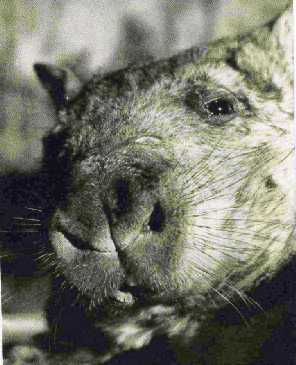
Welcome to a visit with the
Northern Hairy-Nosed Wombat
Lasiorhinus krefftii

Photo Credit Dave Watts

** Click here for photos of my volunteer week with the Wombats**
The following information and photos provided by The Queensland Parks and Wildlife Service
The northern hairy-nosed wombat was known from only three localities: Deniliquin, NSW; St. George, southern Queensland; and Epping Forest, central Queensland. At the time of European settlement, the species may have already been uncommon. It is assumed that drought and grazing pressure from cattle and sheep accelerated the species' decline and that it was extinct in the Deniliquin and St. George areas by 1908. The northern hairy-nosed wombat is now restricted to a single population on Epping Forest National Park near Clermont in central Queensland. In 2003, the population contained 113 individuals, of which only 35 were females. In 2021, the total population number was reported to be about 300.
Queensland Parks and Wildlife Service has produced a recovery plan for the northern hairy-nosed wombat, which outlines the actions needed to halt its decline and enhance the chances for long-term survival in the wild. These actions are being implemented by QPWS as part of a major recovery program to save the northern hairy-nosed wombat. This brochure provides information on the wombat, the threats to its survival and what is being done to conserve the species.

Drawing by Tom Mumbray
Description
Australia has three species of wombat, the northern hairy-nosed wombat Lasiorhinus krefftii, the southern hairy-nosed wombat Lasiorhinus latifrons and the common wombat Vombatus ursinus. The northern hairy-nosed wombat is the largest burrowing herbivorous mammal in the world. This nocturnal marsupial, with its silky grey fur and broad hairy nose, can weigh up to 40kg. Females are slightly heavier than males.
The two species of hairy-nosed wombats are similar in appearance, but differ to the common wombats by having broader, hairy noses, silkier fur and longer ears. The hairy-nosed wombats also differ from the common wombat by living in semi-arid areas of Australia. The southern hairy-nosed wombat occurs in the drier areas of South Australia, Victoria and West Australia; the northern hairy-nosed wombat used to occur in inland areas from the Victorian border to central Queensland. In contrast, the common wombat is found in the wetter coastal and highland areas of mainland Australia and Tasmania.
Habitat
Epping Forest National Park is semi-arid and dominated by brigalow Acacia harpophylla and gidgee A. cambagei on heavy grey, non-cracking soils. Deep alluvial sand deposits are present along an ancient watercourse, on the banks of which the wombats dig burrows. Wombat habitat is dominated by long-fruited bloodwood Corymbia clarksonia, Moreton Bay Ash C. tessellaris and Bauhinia Lysiphyllum hookeri, with a grassy ground cover.
Behaviour
In summer months, northern hairy-nosed wombats will only leave their burrows in the hours of darkness when the air temperature is cooler. On winter mornings and late afternoons, they may be seen sunning themselves above ground. During the dry season (May to October), the wombats are active for about six hours per night. In the wet season (November to April), when more food is available, activity at night decreases to about two hours.

Breeding
Breeding is related to summer rainfall, occurring less frequently during times of drought. Young are born mostly in the wet season. The young remain in the pouch for 8 to 9 months and then stay in the burrow for an unknown period of time, while their mother goes out to feed. Weaning occurs at about 12 months of age, but the young will remain with their mother until 18 months of age.
Threatening Processes
Competition with cattle and sheep, particularly during droughts appears to have been the main factor contributing to the species' decline. Cattle have been removed from Epping Forest National Park, so grazing pressure from livestock is no longer considered a threat. Current threatening processes are: loss of genetic diversity; small population size; predation by dingoes; being restricted to one location; disease and parasites affecting the health of the animals; wildfire and drought destroying food sources; and competition for food from grey kangaroos Macropus giganteus, especially during droughts.
What's being done?
The breeding status, health and population structure of the wombats is being monitored. The habitat is being managed through pasture manipulation, and by the provision of supplementary feed and water. In addition, the fire breaks around the park are maintained, dingoes are excluded from the Park following the construction of a dingo-proof fence in 2002, and the population density of kangaroos monitored at least twice a year.
A captive colony of southern hairy-nosed wombats has been established in Rockhampton to develop assisted breeding and husbandry techniques that can be applied to the northern hairy-nosed wombat. These techniques may include pouch young cross-fostering (transfer of northern hairy-nosed wombat pouch young to southern hairy-nosed wombat pouches), hand-raising of pouch young, semen collection, sperm sexing (to address the sex ratio imbalance), artificial insemination and embryo transfer.
When the population of northern hairy-nosed wombats increases, a second wild population will be established.
Where can I see them?
Sorry, access to Epping Forest National Park is restricted to the wombat managers and researchers to minimize disturbance to the wombats. There are no northern hairy-nosed wombats in captivity, but in Queensland, you can view common and southern hairy-nosed wombats at several zoos including Rockhampton Zoo, Billabong Sanctuary (Townsville), Australia Zoo (Sunshine Coast), Fleays Fauna Sanctuary and Currumbin Sanctuary (both Gold Coast).
For further information on the northern hairy-nosed wombat:
Alan Horsup
Queensland Parks and Wildlife Service
PO Box 3130
Rockhampton Shopping Fair Queensland 4701
Phone (07) 4936 0549
Email: alan.horsup@epa.qld.gov.au
Help the northern hairy-nosed wombat by making a donation to:
Wombat Survival Fund
Queensland Parks and Wildlife Service
PO Box 3130
Rockhampton Shopping Fair Queensland 4701
Email: wombat@epa.qld.gov.au
Links:
Northern Hairy Nosed Wombat Page
Email me at luvwombats@yahoo.com